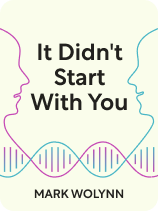

This article is an excerpt from the Shortform book guide to "It Didn't Start With You" by Mark Wolynn. Shortform has the world's best summaries and analyses of books you should be reading.
Like this article? Sign up for a free trial here .
Does positive thinking really work? How can thinking positively affect the brain?
According to Mark Wolynn, the author of It Didn’t Start With You, positive thinking is a form of healing power for those suffering from repressed trauma. He backs it up with scientific research that suggests that our brains want us to visualize experiences or conversations that lift us up.
Read about the healing power of positive thinking.
How Science Validates Healing Through Images
Researchers have confirmed Wolynn’s claim that visualizations and thinking about positive experiences can serve as potent healing tools. To appreciate the healing power of positive thinking, we must look at how our bodies and brains change over time.
Our bodies and brains adapt to our environment and circumstances. When we repeat new, positive experiences—particularly when those experiences feel rewarding and significant—physiological changes start to take place. As Wolynn explains, our bodies release feel-good hormones and activate genes that improve our stress response. Also, our brains start to form new neural connections, which allows us to experience new, positive thoughts and emotions.
Brain scans confirm that simply imagining a conversation or a comforting experience activates the same regions in our brain as if we’re actually living this experience. These findings further validate Wolynn’s healing advice.
Wolynn says to perform healing practices with intention and consistency that emotionally move us. We replace old, painful images, feelings, and memories with new, positive memories and emotions. Then, when old, unhealthy patterns start to surface, we’ll have a totally new internal reference point that will guide us to respond with love, care, and compassion. For example, instead of reacting in anger or shutting down when your mother criticizes you, you will receive her words with grace and true appreciation.
To sustain these physiological changes and integrate the healing power of positive thinking, Wolynn explains that we must repeat our chosen rituals and visualizations regularly. Ultimately, the power of positive thoughts will allow us to align our actions with our goals and intentions, opening the door to new possibilities around our health, freedom, and success.
New Research Shows That Positive Environments Can Facilitate Healing
Positive thinking’s healing powers may help heal trauma, but having positive experiences in real life is arguably more powerful. Wolynn mentions research on mice that show trauma symptoms can be reversed by positive, low-stress environments. If mice experience trauma early in life, such as being separated from their mothers, their trauma can be “corrected” by immersing them in a nurturing environment later in life. Changes in gene expression, neural activity, and behavioral cues are evidence that they’re healing. But does the same thing happen with humans? New research shows promising results.
Since the publication of It Didn’t Start With You, new research shows that positive childhood environments could have similar beneficial effects in humans who endure trauma. Children who are given access to ample free play, affection, family time, and responsive relationships, demonstrate an ability to respond to stressful situations in a more measured, healthy way without becoming overly agitated. These results indicate that positive childhood environments can reduce—and possibly reverse—the physiological imprint of trauma.
This encouraging research is helping service providers design trauma-informed practices for schools and workplaces that build people’s resilience and coping skills. These programs teach people how to manage emotions positively and provide resources aimed at creating environments that are welcoming and sensitive to people who have gone through trauma.

———End of Preview———
Like what you just read? Read the rest of the world's best book summary and analysis of Mark Wolynn's "It Didn't Start With You" at Shortform .
Here's what you'll find in our full It Didn't Start With You summary :
- A look into the causes of persistent anxiety, depression, and illness
- How the traumas of your past are stopping you from being truly happy and free
- How to resolve deeply-rooted trauma by applying a unique therapeutic approach





